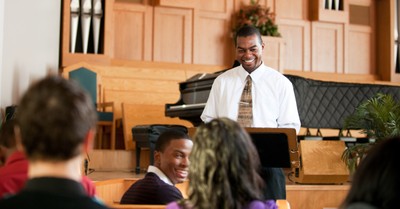In Defense of Marriage: A Glimpse into the Nation's Future
- S. Michael Craven President, Center for Christ & Culture
- Published Aug 11, 2008

All right, you say, so cohabitation is a poor substitute for marriage and may even undermine those marriages preceded by cohabitation. But how does allowing persons of the same sex to marry harm the institution of marriage? As advocates of same-sex marriage (SSM) are quick to point out, “the sky hasn’t fallen” since SSM became legal in Massachusetts in 2004, apparently convinced that four short years is adequate to produce the predictable and deleterious public consequence of redefining marriage. Remember, however, that Unwin’s research demonstrated that the effects of such modification would occur over generations and not be immediate. Nonetheless, there is some empirical evidence already emerging that indicates the acceptance of SSM will, in fact, harm the institution of marriage and, subsequently, society.
Stanley Kurtz, senior fellow at Stanford University’s Hoover Institute, reported in April of 2004 before the House Judiciary Committee that there is ample evidence available in Scandinavia demonstrating the effect of devolving marriage to include couples of the same sex. Dr. Kurtz holds a PhD in social anthropology from Harvard University and is regarded as both an excellent scholar and expert in this area. Commenting on the situation in Sweden, Kurtz writes:
The Swedes have simply drawn the final
conclusion: If we’ve come so far without marriage, why marry at all?
Our love is what matters, not a piece of paper. Why should children
change that? (Stanley Kurtz, “The End of Marriage in Scandinavia: The
‘conservative case’ for same-sex marriage collapses,” The Weekly Standard, 2 February 2004.)
Indeed, in Sweden the out-of-wedlock birthrate is 55 percent, Norway is 50 percent, Iceland is approaching 70 percent, and in Denmark 60 percent of firstborn children are born out of wedlock. So what? you ask. So cohabitation has replaced marriage, big deal; men and women are still having children, only without the formality of a marriage certificate. What’s the problem? According to Dr. Kurtz, studies in these countries demonstrate that these unmarried families break up at a rate two to three times that of married couples. This has only exacerbated the welfare state that is unparalleled in Scandinavia. Kurtz points out that “no western nation has a higher percentage of public employees, public expenditures, or higher tax rates than Sweden.”
And what does this have to do with SSM? All of the Scandinavian countries mentioned embraced de facto same-sex marriage, beginning with Denmark in 1989. The out-of-wedlock birth rates mentioned experienced their most dramatic increases in the decade following the acceptance of SSM in these countries. The separation of marriage from procreation and parenting was already increasing, as it is here; SSM only widened the separation. “In Scandinavia, gay marriage has driven home the message that marriage itself is outdated, and that virtually any family form, including out-of-wedlock parenthood is acceptable” (Kurtz, “The End of Marriage”).
Dr. Kurtz offers further insight into the connection between cohabitation, rising out-of-wedlock birthrates, and same-sex marriage:
British demographer Kathleen Kiernan .
. . divides the continent into three zones. The Nordic countries are
the leaders in cohabitation and out-of-wedlock births. They are
followed by a middle group that includes the Netherlands, Belgium,
Great Britain, and Germany . . . North American rates of cohabitation
and out-of-wedlock birth put the United States and Canada into this
middle group. Most resistant to cohabitation, family dissolution, and
out-of-wedlock births are the southern European countries of Portugal,
Italy, and Greece . . . These three groupings closely track the
movement for gay marriage. In the late eighties and early nineties, gay
marriage came to the Nordic countries, where the out-of-wedlock
birthrate was already high. Ten years later, out-of-wedlock birthrates
have risen significantly in the middle group of nations. Not
coincidentally, nearly every country in that middle group has recently
either legalized some form of gay marriage, or is seriously considering
doing so. Only in the group with low out-of-wedlock birthrates has the
gay marriage movement achieved relatively little success.
Kurtz concludes by saying, “This suggests that gay marriage is both an effect and a cause of the increasing separation between marriage and parenthood. As rising out-of-wedlock birthrates disassociate heterosexual marriage from parenting, gay marriage becomes conceivable” In essence, SSM is simply the extreme and final step in a culture’s descent from absolute monogamy.
Again, if marriage is only about a relationship between two people, and is not intrinsically connected to procreation and parenthood, why shouldn’t same-sex couples be allowed to marry? As Kurtz points out, “it quite naturally follows that once marriage is redefined to accommodate same-sex couples, that change cannot help but lock in and reinforce the very cultural separation between marriage, procreation and parenthood that makes gay marriage conceivable to begin with.” The die will be cast and the effects inevitable.
Furthermore, gay marriage has not strengthened the institution of marriage by promoting fidelity and commitment among gays in Scandinavia, as some suggest it will do here. In fact, take-up rates on gay marriage are exceedingly small. Yale law professor William Eskridge (an advocate for gay marriage) acknowledged this when “he reported in 2000 that only 2372 couples had registered after nine years of the Danish law going into effect, 674 after four years in Norway, and only 749 couples after four years in Sweden” (Kurtz, “The End of Marriage”). Here again, Kurtz is helpful in illuminating our understanding:
Danish social theorist Henning Bech and
Norwegian sociologist Rune Halvorsen offer excellent accounts of the
gay marriage debates in Denmark and Norway. Bech, who is perhaps
Scandinavia’s most prominent gay thinker, dismisses as an implausible
claim the idea that gay marriage promotes monogamy. He treats this
claim as something that only served a tactical purpose during the
difficult political debate.
According to Halvorsen, many of Norway’s gays imposed self-censorship during the marriage debate, in order to hide their opposition to marriage itself. The goal of the gay marriage movements in Norway and Denmark, say Halvorsen and Bech, was not marriage but social approval for homosexuality. Halvorsen goes on to suggest that the low numbers of registered gay couples may be understood as a collective protest against the expectations (presumably, monogamy) embodied in marriage.
According to Halvorsen, many of Norway’s gays imposed self-censorship during the marriage debate, in order to hide their opposition to marriage itself. The goal of the gay marriage movements in Norway and Denmark, say Halvorsen and Bech, was not marriage but social approval for homosexuality. Halvorsen goes on to suggest that the low numbers of registered gay couples may be understood as a collective protest against the expectations (presumably, monogamy) embodied in marriage.
While the sky may not have fallen, effects that have historically taken generations to produce have already begun to manifest within just twenty years of the acceptance of SSM in Scandinavia, the first nations to risk their future on this perilous social experiment.
© 2008 by S. Michael Craven
Comment on this article here
Subscribe to Michael's weekly commentary here
Subscribe to Michael's podcast here
S. Michael Craven is the founder and President of the Center for Christ & Culture. Michael is the author of Uncompromised Faith: Overcoming Our Culturalized Christianity, published by Navpress and scheduled for release January 2009. Michael's ministry is dedicated to renewal within the Church and works to equip Christians with an intelligent and thoroughly Christian approach to matters of culture in order to demonstrate the relevance of Christianity to all of life. For more information on the Center for Christ & Culture, the teaching ministry of S. Michael Craven, visit: www.battlefortruth.org
Michael lives in the Dallas area with his wife Carol and their three children.




















